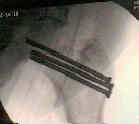- See:

- Distal Femoral Physeal Fractures
- Hip Fractures in Children
- IM Nailing of Pediatric Femoral Fractures
- Discussion:
- commonest site of fracture of the femoral shaft is in its middle third, where normal anterolateral bowing
of the diaphysis is at its maximum;
- torsional force produced by indirect violence results in a long spiral or oblique frx, whereas a transverse
frx is caused by direct trauma;
- green stick frx are more common in the distal third;
- birth frx from OB trauma, usually occur in mid 1/3 & are transverse;
- deforming forces:
- displacement of the fragments in frx of the femur depends upon the breaking force, the pull of the muscles, and gravity;
- distal fragment is laterally rotated due to outward rotation of the leg by the force of gravity;
- in frx of upper 1/3 of the femoral shaft, the prox frag is pulled into flexion by the psoas, into abduction by gluteus medius &
minimus, & into E.R by external rotators;
- diff dx:
- child abuse;
- it is published that up to one half of infants and young children who sustain femur fractures are victims of child abuse;
- also be aware that many of the "abuse" cases often occur from poor judgement, such as letting children ride on the
hood of a slow moving car;
- also note that many pediatric femur frx cases do not stem from abuse, and it is important for the orthopaedist not to
alienate the parents by making ill worded comments about abuse;
- bone tumor
- be suspcious of femoral shaft fractures occuring from low energy trauma such as a football pile up;
- poor quality films may mask a NOF, UBC, or even osteosarcoma;
- associated injuries:
- vascular injury:
- excessive bleeding ( > 500 ml) or more is not uncommon;
- source of bleeding is usually the profundus femoris artery which course around femoral shaft, the vessels of richly vascular
muscles enveloping the femur, or the vessels in bone itself;
- ligamentous injuries:
- references:
- Ligamentous instability of knee in children sustaining fractures of femur: study with knee examination under anesthesia
- Femoral fractures: are children at risk for significant blood loss?
- Paediatric femoral shaft fractures: What are the concomitant injuries?
- Treatment Based on Age:
- infants: 0 to 2 yrs
- children: 2 to 10 yrs
- children aged > 10 yrs
- reference:
- Remodelling of angular deformity after femoral shaft fractures in children
- Non Operative Treatment:
- suspension traction
- femoral traction pins
- references:
- Temporizing Management of Pediatric Femur Fractures Using J-splints
- Skeletal traction for fractures of the femoral shaft in children. A long-term study
- spica cast:
- anesthesia: even though this is not an operative procedure, some patients may require GEA;
- key to minimizing the amount of shortening is to place lower extremity in relaxed position;
- involves hip flexion, abduction, external rotation & knee flexion;
- position & alignment of the frx frag are checked by periodic x-rays;
- do not allow distraction of the fragments to take place;
- Operative Intervention:

- children who have uncontrolled muscle spasticity, such as those w/ head injuries or severe CP,
do not tolerate external immobilization well;
- in the study by Sanders JO, et al., the authors determined preferance patterns of various femoral
fracture patterns in children by pediatric orthopedists and whether it is practice dependent;
- authors noted a statistically significant trend by pediatric orthopedists to treat older children's
femur frx operatively and younger children's nonoperatively;
- avascular necrosis after rigid rodding remains a concern;
- references: Treatment of Femoral Fractures in Children by Pediatric Orthopedists: Results of a 1998 Survey
- external fixation
- IM nailing of pediatric femur frx:
- bridge plating / sliding hip screw fixation:
- sliding screw is inserted just proximal to the proximal femoral physis;
- references:
- Submuscular bridge plating for complex pediatric femur fractures is reliable.
- Fractures and Refractures After Femoral Locking Compression Plate Fixation in Children and Adolescents
- Distal Femoral Valgus Deformity Following Plate Fixation of Pediatric Femoral Shaft Fractures
- Comparison of titanium elastic nail and plate fixation of pediatric subtrochanteric femur fractures
- Biomechanical analysis comparing titanium elastic nails with locked plating in two simulated pediatric femur fracture models.
- Plate fixation of femoral shaft fractures in multiply injured children
- Compression plating of pediatric femoral shaft fractures
- Pediatric Diaphyseal Femur Fractures: Submuscular Plating Compared With Intramedullary Nailing
- Complications:
- overgrowth:
- Femoral shaft fractures in children: a prospective study of the overgrowth phenomenon
- Prediction of overgrowth in femoral shaft fractures in children
- Overgrowth of the femur following fractures in children: influence of handedness
- Femoral shaft fractures in children: the effect of initial shortening on subsequent limb overgrowth
- Overgrowth of the femur after Internal Fixation in Children with Femoral Shaft Fracture - A Multicenter Study.
- rotation malalignment:
- ref: Rotational deformity and remodeling after fracture of the femur in children
Residual bone-mineral density and muscle strength after fractures of the tibia or femur in children
Open fractures of the diaphysis of the lower extremity in children. Treatment, results, and complications
Ipsilateral fractures of the femur and tibia in children and adolescents
Management of Closed Femoral Shaft Fractures in Children, Ages 6 to 10: National Practice Patterns and Emerging Trends
Pediatric Femoral Fractures: A Systematic Review of 2422 Cases
The "floating knee" in children
American Academy of Orthopaedic Surgeons Clinical Practice Guideline on Treatment of Pediatric Diaphyseal Femur Fracture
Guideline on the Treatment of Pediatric Diaphyseal Femur Fractures

